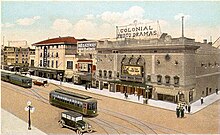Frank Julian Sprague
Frank Julian Sprague (born July 25, 1857 in Milford , Connecticut , † October 25, 1934 ) was an American naval officer and inventor . In the USA he is known as the “father of electric traction ” and made significant contributions to the development of electric motors , electric trains and elevators .
Early developments
Frank Julian Sprague attended Drury High School , where he showed excellence in mathematics . In 1874 he began studying at the United States Naval Academy in Annapolis , Maryland , which he graduated in 1878 as the seventh best of his class. He then served on various ships in the US Navy , where he installed the first electrical signal call system on a Navy ship on the USS Lancaster .
Sprague left in 1881 to attend the Paris Electricity Exhibition and the Crystal Palace Exhibition in Sydenham , England in 1882. There he was a jury member for the award ceremony for gas engines , dynamos and lamps.
Edison employees
In 1883 a business partner of Thomas Alva Edison persuaded him to work. Sprague introduced mathematical methods into Edison's laboratory, which reduced the considerable effort of the trial-and-error methods pursued up until then . He improved Edison's system of wiring and distribution in electrical systems. In 1884 he decided to go his own way and founded the Sprague Electric Railway & Motor Company .
Sprague's company introduced two major improvements in 1886: the constant rotating electric motor with non-sparking fixed brushes and the energy recovery from electrically powered devices. For the first time, constant speeds with changing loads could be achieved with his engine. Edison praised this as the only practical engine of its time. The method of energy recovery is also considered essential to the development of electric railways and elevators.
Electric railways
In 1888, Sprague developed a streetcar that took its power from an overhead line , creating the first successful large-scale electric streetcar system in Richmond , Virginia . Gradients of up to 10% were conquered on the hills of Richmond, which proved to be a convincing touchstone for the application of the new technology in other cities. Within a year, electricity had prevailed over the horse business, and by 1889 110 electric railways with Sprague's equipment were under construction or in the planning stage. Edison, who made Sprague's equipment, bought him in 1890.
Sprague's experience with elevator control prompted him to plan an all-axle drive for multiple units at an early stage. In its multiple unit system , each car had its own drive motor. The train driver should be able to control the train journey evenly and more efficiently via relays and continuous electrical lines . This should save special locomotives.
Sprague's first job with this technique came from the South Side Elevated Railway in Chicago . The successful use led to further orders in Brooklyn , New York and in Boston .
From 1896 to 1900, Sprague served on the New York Central Railroad to electrify the railway stations, especially the Grand Central Terminal in New York City . Here he developed an automatic train protection system and then founded the Sprague Safety Control & Signal Corporation to further develop and sell his system.
Electric elevators
Sprague turned to the development of electric elevators after 1890 and founded the Sprague Electric Elevator Company in 1892 and developed the Sprague-Pratt Electric Elevator with Charles R. Pratt , which was faster and more powerful than the hydraulic or steam-powered elevators. Sprague then sold his company to the Otis Elevator Company .
In the 1920s he designed a system to operate two independent elevators in a common shaft as well as security systems. Sprague then sold its system to Westinghouse Electric Corporation .
Awards and bequests
Sprague received the Gold Medal at the Paris Electricity Exhibition in 1889, the Grand Prize at the St. Louis Exhibition in 1904 and the Elliott Cresson Medal , the Edison Medal in 1910 , the Franklin Medal in 1921 and, posthumously, the John Fritz Medal in 1935 Gold.
With his wife Harriet, Sprague had two sons, Robert and Julian. After his death in 1934, Sprague was buried in Arlington National Cemetery. His widow donated numerous items from his property to the New York Public Library . In 1959, with donations of Harriet Sprague the Sprague Building at Shoreline Trolley Museum in East Haven ( Connecticut built) far from Sprague's hometown Milford. The museum is the oldest operating tram museum and has one of the largest collections in the United States.
In 1999, two grandchildren, John L. Sprague and Peter Sprague, cut the ribbon and started an 1884 Sprague engine and a new permanent exhibit, Frank J. Sprague: Inventor, Scientist, Engineer , at the Shore Line Trolley Museum.
Web links
- Frank J. Sprague historical information (English)
- Shore Line Trolley Museum - new permanent exhibit: "Frank J. Sprague: Inventor, Scientist, Engineer" (English)
- Some personal experiences (English)
| personal data | |
|---|---|
| SURNAME | Sprague, Frank Julian |
| BRIEF DESCRIPTION | American naval officer and inventor |
| DATE OF BIRTH | July 25, 1857 |
| PLACE OF BIRTH | Milford , Connecticut |
| DATE OF DEATH | October 25, 1934 |

